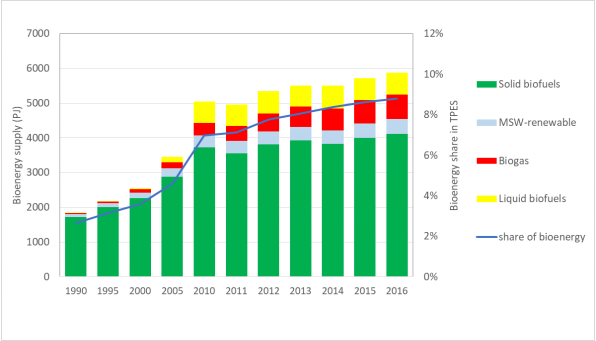IEA Bioenergy recently published in-depth analyses of current bioenergy state-of-art within different countries.
These country reports are based on IEA statistical data, combined with data and information provided by the IEA Bioenergy Executive Committee and its Tasks.
Each report is structured as follows:
- Analysis of national policy framework and related renewable energy targets;
- Total Primary Energy Supply (TPES) by resource and the contribution of bioenergy (IEA statistics 2016);
- Relevant funding programs, major research institutes and projects;
- Latest development trends within bioenergy.
Bioenergy policies and status of implementation – Europe
EU Policy framework
Europe country report opens with a summary of the Renewable Energy Directive (2009/28/EC) and its targets within European final energy consumption and transport sector by 2020. To be counted within the transport target, biofuels need to meet specific sustainability criteria such as a lifecycle GHG emission reduction of at least 35% by 2017 and of 50% (up to 60% for new installations) afterward.
Alongside the Renewable Energy Directive, the amended Fuel Quality Directive (FQD) 2009/30/EC requires the road transport fuel mix in the EU to be 6% less carbon intensive than a fossil diesel and gasoline baseline by 2020. At the end of September 2015, Directive (EU) 2015/1513 (amending RED I and the Fuel Quality Directive) introduced an indicative 0.5% target for advanced biofuels (in reference for national targets) and confirmed the minimum of 60% GHG savings for biofuels produced in installations running after October 2015. A report from the EU Commission, along with a Staff Working Document, addressed the sustainability issue of biomass sources in electricity and heating & cooling sectors, prior to the definition of 2030 Climate and Energy Policy Framework targets as the first attempt to elaborate a comprehensive post-2020 policy framework.
A proposal of a new Renewable Energy Directive has been eventually agreed on June 14, 2018: it will enter in force on 1 January 2021. It envisages further strengthening sustainability criteria for biofuels used in transport as well as extending them to solid and gaseous biomass fuels used for power and heating & cooling production. A risk-based approach will be adopted with regard to forest biomass in order to minimise LULUCF (Land Use and Land use Change and Forestry).
Statistics explained

Speaking of 28 EU Member states, bioenergy represented about two thirds of renewable energy sources (5,881 PJ -Petajoules-, 8.8% on a total of 66,927 PJ) within 2016 TPES.
Considering a EU population of 511.3 million, each European citizen consumed 130.9 GJ/capita of TPES in 2016 (11.5 accounting for bioenergy consumption per capita).
Most of it (about 70%) derives from solid biofuels, followed by biogas, biodiesel, renewable municipal waste and biogasoline. Despite this, biogas was the one with the highest increasing trend between 2011 and 2016 (about 11%/y).
Concerning bioenergy distribution amongst different sectors, the share of bioenergy within the total consumption accounts for 5.6% in the production of electricity, for 4.4% in transportation sector (transport biofuels) and for 2.4% in overall fuel and heat consumption (whereas direct biomass stands for 15.0%).
To read the summary of all country reports click here.
To read the full Europe Country Report “European Union – 2018 update Bioenergy policies and status of implementation, including research focus related to bioenergy” click here.


